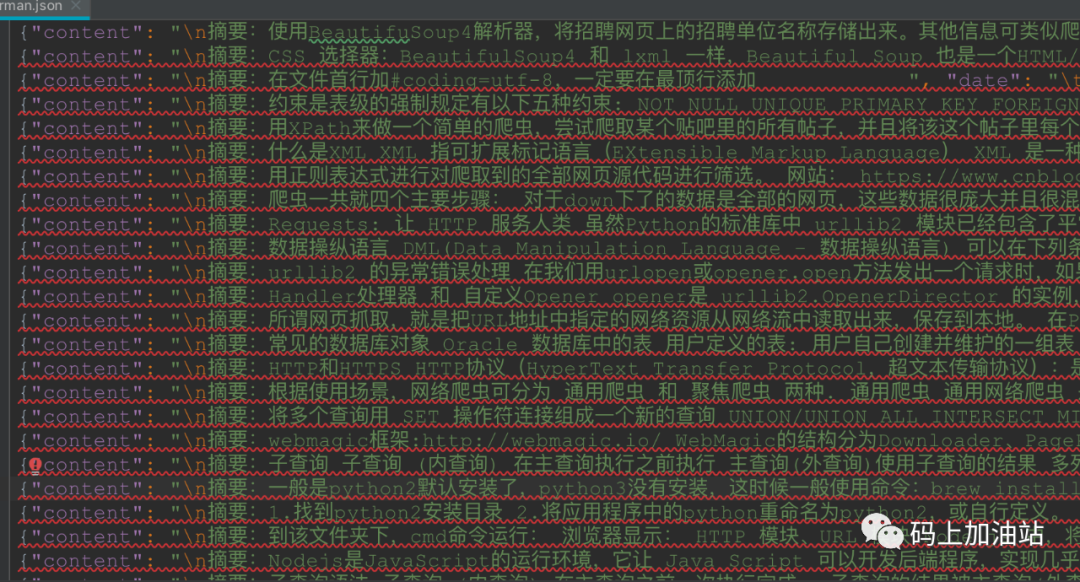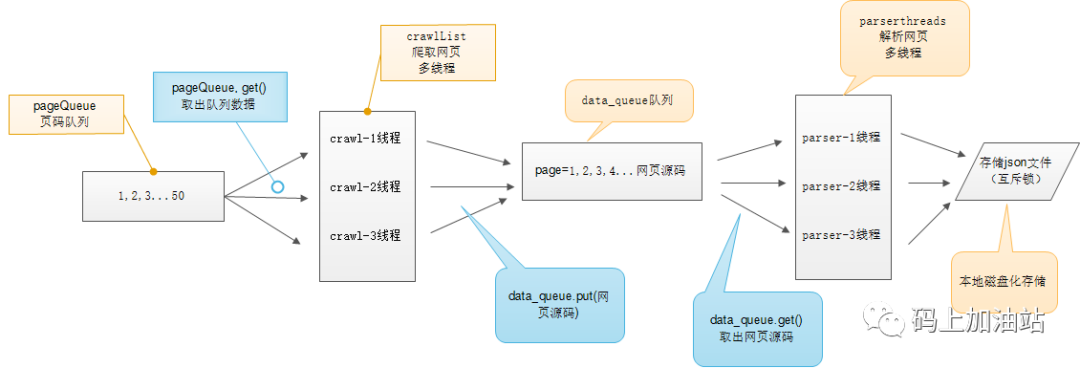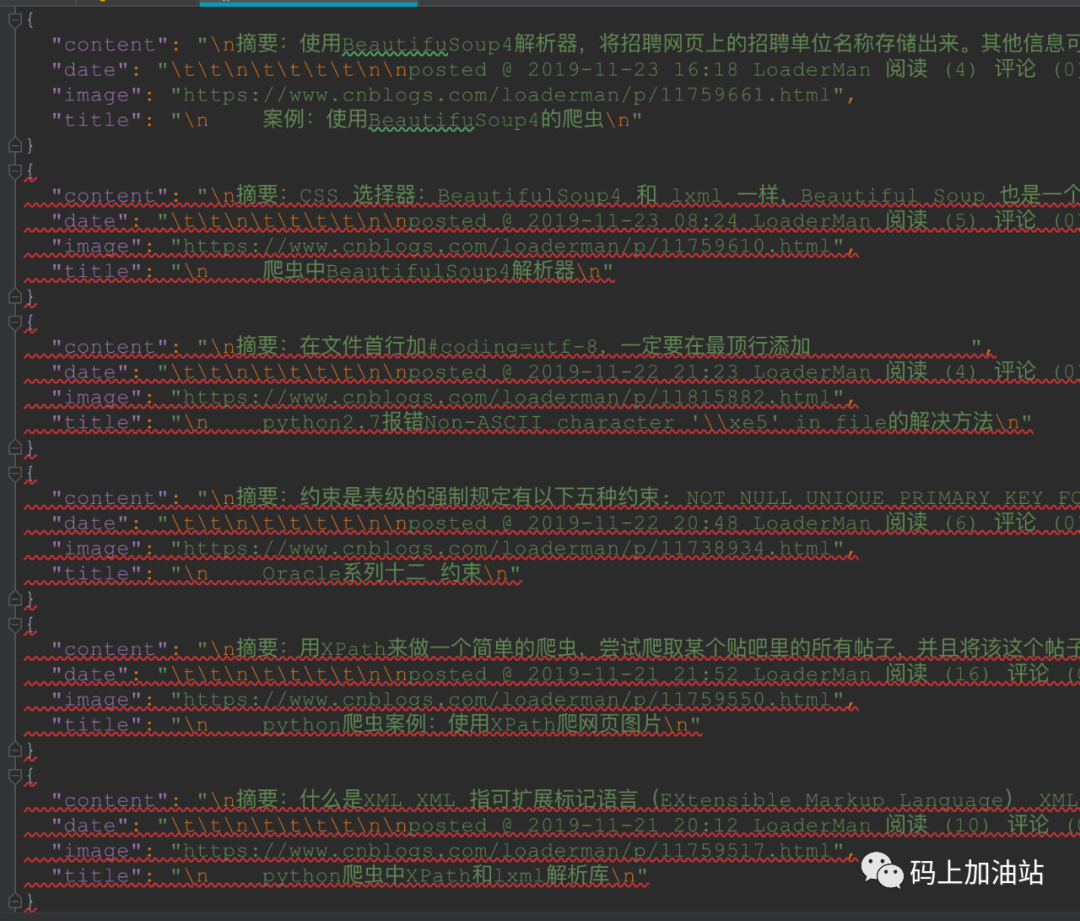
爬取博客园文章列表
爬取博客园文章列表,假设页面的URL是https://www.cnblogs.com/loaderman
要求:使用requests获取页面信息,用XPath / re 做数据提取 获取每个博客里的标题,描述,链接地址,日期等保存到 json 文件内
示例:
# -*- coding:utf-8 -*-
import urllib2
import json
from lxml import etree
url = "https://www.cnblogs.com/loaderman/"
headers = {"User-Agent": "Mozilla/5.0 (compatible; MSIE 9.0; Windows NT 6.1; Trident/5.0;"}
request = urllib2.Request(url, headers=headers)
html = urllib2.urlopen(request).read()
# 响应返回的是字符串,解析为HTML DOM模式 text = etree.HTML(html)
text = etree.HTML(html)
# 返回所有结点位置,contains()模糊查询方法,第一个参数是要匹配的标签,第二个参数是标签名部分内容
node_list = text.xpath('//div[contains(@class, "post")]')
print (node_list)
items = {}
for each in node_list:
print (each)
title = each.xpath(".//h2/a[@class='postTitle2']/text()")[0]
detailUrl = each.xpath(".//a[@class='postTitle2']/@href")[0]
content = each.xpath(".//div[@class='c_b_p_desc']/text()")[0]
date = each.xpath(".//p[@class='postfoot']/text()")[0]
items = {
"title": title,
"image": detailUrl,
"content": content,
"date": date,
}
with open("loaderman.json", "a") as f:
f.write(json.dumps(items, ensure_ascii=False).encode("utf-8") + "\n")效果:

多线程爬虫案例
Queue是python中的标准库,可以直接import Queue引用;队列是线程间最常用的交换数据的形式
python下多线程的思考
对于资源,加锁是个重要的环节。因为python原生的list,dict等,都是not thread safe的。而Queue,是线程安全的,因此在满足使用条件下,建议使用队列
初始化:class Queue.Queue(maxsize) FIFO 先进先出
包中的常用方法:
Queue.qsize() 返回队列的大小
Queue.empty() 如果队列为空,返回True,反之False
Queue.full() 如果队列满了,返回True,反之False
Queue.full 与 maxsize 大小对应
Queue.get([block[, timeout]])获取队列,timeout等待时间
创建一个“队列”对象
import Queue
myqueue = Queue.Queue(maxsize = 10)
将一个值放入队列中
myqueue.put(10)
将一个值从队列中取出
myqueue.get()
示意图:

# -*- coding:utf-8 -*-
# 使用了线程库
import threading
# 队列
from Queue import Queue
# 解析库
from lxml import etree
# 请求处理
import requests
# json处理
import json
import time
class ThreadCrawl(threading.Thread):
def __init__(self, threadName, pageQueue, dataQueue):
# threading.Thread.__init__(self)
# 调用父类初始化方法
super(ThreadCrawl, self).__init__()
# 线程名
self.threadName = threadName
# 页码队列
self.pageQueue = pageQueue
# 数据队列
self.dataQueue = dataQueue
# 请求报头
self.headers = {"User-Agent": "Mozilla/5.0 (compatible; MSIE 9.0; Windows NT 6.1; Trident/5.0;"}
def run(self):
print "启动 " + self.threadName
while not CRAWL_EXIT:
try:
# 取出一个数字,先进先出
# 可选参数block,默认值为True
# 1. 如果对列为空,block为True的话,不会结束,会进入阻塞状态,直到队列有新的数据
# 2. 如果队列为空,block为False的话,就弹出一个Queue.empty()异常,
page = self.pageQueue.get(False)
url = "https://www.cnblogs.com/loaderman/default.html?page=" + str(page)
# print url
content = requests.get(url, headers=self.headers).text
time.sleep(1)
self.dataQueue.put(content)
# print len(content)
except:
pass
print "结束 " + self.threadName
class ThreadParse(threading.Thread):
def __init__(self, threadName, dataQueue, filename, lock):
super(ThreadParse, self).__init__()
# 线程名
self.threadName = threadName
# 数据队列
self.dataQueue = dataQueue
# 保存解析后数据的文件名
self.filename = filename
# 锁
self.lock = lock
def run(self):
print "启动" + self.threadName
while not PARSE_EXIT:
try:
html = self.dataQueue.get(False)
self.parse(html)
except:
pass
print "退出" + self.threadName
def parse(self, html):
# 解析为HTML DOM
html = etree.HTML(html)
node_list = html.xpath('//div[contains(@class, "post")]')
print (node_list)
items = {}
for each in node_list:
print (each)
title = each.xpath(".//h2/a[@class='postTitle2']/text()")[0]
detailUrl = each.xpath(".//a[@class='postTitle2']/@href")[0]
content = each.xpath(".//div[@class='c_b_p_desc']/text()")[0]
date = each.xpath(".//p[@class='postfoot']/text()")[0]
items = {
"title": title,
"image": detailUrl,
"content": content,
"date": date,
}
with open("loadermanThread.json", "a") as f:
f.write(json.dumps(items, ensure_ascii=False).encode("utf-8") + "\n")
CRAWL_EXIT = False
PARSE_EXIT = False
def main():
# 页码的队列,表示20个页面
pageQueue = Queue(20)
# 放入1~10的数字,先进先出
for i in range(1, 21):
pageQueue.put(i)
# 采集结果(每页的HTML源码)的数据队列,参数为空表示不限制
dataQueue = Queue()
filename = open("duanzi.json", "a")
# 创建锁
lock = threading.Lock()
# 三个采集线程的名字
crawlList = ["采集线程1号", "采集线程2号", "采集线程3号"]
# 存储三个采集线程的列表集合
threadcrawl = []
for threadName in crawlList:
thread = ThreadCrawl(threadName, pageQueue, dataQueue)
thread.start()
threadcrawl.append(thread)
# 三个解析线程的名字
parseList = ["解析线程1号", "解析线程2号", "解析线程3号"]
# 存储三个解析线程
threadparse = []
for threadName in parseList:
thread = ThreadParse(threadName, dataQueue, filename, lock)
thread.start()
threadparse.append(thread)
# 等待pageQueue队列为空,也就是等待之前的操作执行完毕
while not pageQueue.empty():
pass
# 如果pageQueue为空,采集线程退出循环
global CRAWL_EXIT
CRAWL_EXIT = True
print "pageQueue为空"
for thread in threadcrawl:
thread.join()
print "1"
while not dataQueue.empty():
pass
global PARSE_EXIT
PARSE_EXIT = True
for thread in threadparse:
thread.join()
print "2"
with lock:
# 关闭文件
filename.close()
print "谢谢使用!"
if __name__ == "__main__":
main()效果:


完
码上加油站
一起来加油
长按扫码关注
 记得点个赞和在看哦!
记得点个赞和在看哦!积分赛中创造历史!...)





参数估计问题)








)



